Contents
Market Overview
Optimism reached a new level after the UK regulator approved the Pfizer/BioNTech vaccine. U.S. Treasuries closed out the week +8-9 bps wider as 2s10s approached 80 bps and 5y5y inflation rose to 2.30%. It is also worth noting that with 10yr U.S. breakevens rising to 1.87% and U.S. IG indices rallying to all-time lows in yield, most are now in negative real yield territory which serves to increase the appeal of EM credit. It remains to be seen if the apparent rift between Powell and Mnuchin will dent the reflation theme after speculation out of the Senate Banking Committee testimonies, but the FOMC on December 14-15 is expected to be a benign event. Hopes around fiscal stimulus continue to murmur in the background, although this at least fueled the Dow Jones back above 30k. Risk sentiment did take a knock on Thursday as Pfizer announced supply constraints and guided FY20 supply of 50m rather than 100m doses, which coincided with Governor Newsom announcing stricter measures in California (headlines were five minutes apart). Crude oil markets were also volatile and traded up to 9-month highs, where OPEC+ talks ended with an agreement to increase production by 500k bpd from January, but supply will be reassessed at monthly meetings. Elsewhere, Brexit talks intensified and ambiguously “entered the tunnel” which saw GBP trade up to 1.35, in spite of the French veto threat and even the ECB’s Philip Lane was unable to talk EUR down below 1.20. New highs for CNH day-by-day were also a regular feature, with improved NBS and Caixin PMI data as the currency seems set to test 6.50 (helped by copper trading up to $7,675/t). Warmer relations are also brewing in the Middle East as Saudi Arabia and Qatar are nearing an end to the three year dispute as rapprochement is set to include reopening airspace and land borders. EM credit ended the week up 0.5% with spreads 13 bps tighter, meaning December is already following the impressive bout in November. The outperformance in spreads is largely a product of U.S. Treasuries widening, where Suriname, Ethiopia and Iraq contributed to performance, while Lebanon, Sri Lanka and Argentina lagged.
Next week we can expect rate decisions out of Brazil (2%), Peru (0.25%) and Ukraine (6%). China in itself may dominate the tape with FX reserves, M2, trade data and inflation. We will also have inflation prints out of Chile, Colombia, Czech Republic, Hungary, Mexico, Romania and South Africa. South Africa’s inflation number coincides with its 3Q GDP release, which ought to show a sharp rebound given the low base recovery. Focus is beginning to shift onto Turkey’s next MPC review on December 24, but in the meantime, the current account release will be watched after higher CPI inflation last week. However, this all begins with credit rating updates from Fitch (Croatia, BBB-), S&P (Romania, BBB-) and Moody’s (Russia, Baa3).
Fixed Income
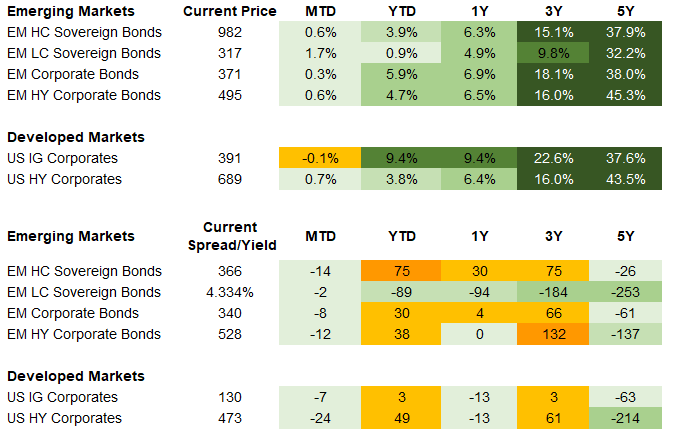
Equities
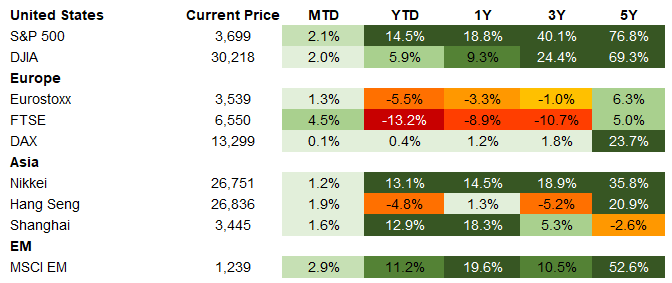
Commodities

Source for data tables: Bloomberg, JPMorgan, Gramercy. EM Fixed Income is represented by the following JPMorgan Indicies: EMBI Global, GBI-EM Global Diversified, CEMBI Broad Diversified and CEMBI Broad High Yield. DM Fixed Income is represented by the JPMorgan JULI Total Return Index and Domestic High Yield Index. Fixed Income, Equity and Commodity data is as of December 4, 2020 (Mid Afternoon).
Emerging Markets Weekly Highlights
Gramercy hosts call with Argentina’s Minister of Economy, Martín Guzmán, Turkey’s inflation overshoots expectations in November, but likely supports the Central Bank’s political mandate to continue tightening monetary policy, OPEC+ reaches agreement to gradually taper cuts starting in January, U.S. Congress passes a bill that adds scrutiny to U.S.-listed Chinese companies and Global emerging market corporates in focus: ESG and sustainability – Going mainstream in the Eurobond market.
Gramercy hosts call with Argentina’s Minister of Economy, Martín Guzmán
Event: Robert Koenigsberger and Mohamed A. El-Erian led a conversation this week with Martín Guzmán which reflected on key aspects of Argentina’s recent restructuring, current and structural economic challenges, and broad parameters for an inclusive solution to restore growth and debt sustainability. This aligns with the IMF’s press release published after the mission’s visit last month which confirmed the authorities’ intent to request an Extended-Fund Facility (EFF).
Gramercy commentary: We view Guzmán’s recognition and understanding of the multi-faceted nature and importance of Argentina’s fiscal problem and need for a comprehensive solution as positive. There continues to be an emphasis on gradual consolidation which does not threaten growth. The increased focus on incorporation of human capital development, not just social considerations, points to greater potential for more sustainable growth-oriented spending. Additionally, programs to support private sector initiatives, such as “Plan Gas”, and others in technology and construction sectors could further support a well-rounded recovery, particularly if political buy-in and restoration of confidence is achieved. Guzmán acknowledged that while the government’s decision to sequence its restructuring ahead of an IMF deal has prevented an immediate triggering of a virtuous cycle, the authorities were prioritizing avoidance of hard default. This sequencing has resulted in the need for ad-hoc policymaking to bridge the gap to a more robust macroeconomic agenda. After a rocky start in September, the Administration’s more recent and relatively more orthodox approach to alleviating FX pressures and combatting inflation have achieved temporary stability. If the government is able to deliver a comprehensive plan, reach an agreement with the IMF in 1H21 as we expect with early evidence of gradual FX reserve build, asset prices should begin to recover more meaningfully as the year progresses.
Turkey’s inflation overshoots expectations in November, but likely supports the Central Bank’s political mandate to continue tightening monetary policy
Event: Headline inflation (CPI) rose to 14.0% YoY in November from 11.9% in October, surprising significantly to the upside market expectations of 12.7%. Higher food and transportation prices were the main drivers behind the pickup in inflation last month.
Gramercy commentary: We look at the November inflation print from the perspective of its implications for the ongoing pivot by Turkey’s authorities to a more market-friendly economic policy mix. The trajectory of economic policy is the key factor that will drive Turkish assets’ performance by year-end and into 2021. As we have argued on multiple occasions recently, maintaining a sufficiently tight monetary policy stance, i.e. onshore real interest rates of at least 3%, is the main pre-condition for gradually restoring public and investor confidence in Turkey’s economic policy framework. Last month’s constructive personnel changes at the top of President Erdogan’s economic team alongside the simplification and tightening of CBRT’s monetary policy framework were material steps in the right direction, but the authorities will likely need to follow through with further measures. The jump in inflation in November highlights the need to maintain and potentially increase a monetary policy tightening bias in order to re-anchor inflation expectations and provide incentives for local corporates and households to embark on a de-dollarization trend and for foreign corporates to take off their FX hedges. The good news for markets is that currently the CBRT appears to have the all-important political backing for fighting inflation and the elevated November print should further support that mandate. As such, we believe that another hike of CBRT’s main policy rate (i.e. the 1-week repo rate) is on the table for the next monetary policy meeting in December. We think that a policy rate of around 17-17.5% at year-end (i.e. 200-250 bps higher than current) will likely be sufficient to reassure markets on CBRT’s inflation-fighting mandate/intentions and secure the positive real rates buffer needed to support de-dollarization of local bank deposits. In addition, a combination of tighter policy mix into 2021 and expected recovery in the economy’s tourism receipts will help with the consolidation of Turkey’s structural external deficit next year, providing another tailwind for the currency.
OPEC+ reaches agreement to gradually taper cuts starting in January
Event: After a week of debate, OPEC+ reached a final agreement on how to proceed with a scheduled tapering of the Easter cuts. The meeting follows a series of public impasses between key OPEC+ members, particularly Saudi Arabia and the United Arab Emirates. The Easter agreement stipulated 7.7 mb/d in cuts through year-end and 5.8 mb/d starting in January through April 2022. Some OPEC+ members, led by Saudi Arabia and Russia, were promoting a three to six month extension of the 7.7 mb/d cuts. However, there was disagreement within the group, particularly due to a recent surge in prices on the back of positive vaccine developments, the return of Libyan output as well as moderate levels of non-compliance by some OPEC+ members. On Thursday, OPEC+ decided on a middle-way: a gradual tapering of cuts starting in January. Rather than giving back 2 mb/d in January, the group will now adjust production by 0.5 mb/d to 7.2 mb/d in January and agree to meet monthly to decide the gradual tapering towards 5.8 mb/d.
Gramercy commentary: The OPEC+ interim agreement is welcome news. Gramercy views that the normalization and gradual recovery in oil markets is mainly due to clear leadership from OPEC+. The oil market is currently undersupplied, but still processing a historic accumulation of inventories. The 1-month tapered extension of the 7.7 mb/d (to 7.2 mb/d) will most likely keep the market undersupplied and lead to a continued reduction in global inventories. We believe that OPEC+ will continue to demonstrate proactive leadership amidst a historic drop in oil demand due to the COVID-19 pandemic, as long as they are able to demonstrate a growing or stable market share particularly vis-à-vis a recovery in U.S. production. As such, our view is that the two key drivers of oil demand are: (1) a path for demand recovery (particularly in light of recent developments with a potential COVID-19 vaccine roll-out) and (2) a path for recovery in U.S. shale production (which should remain subdued at current prices).
U.S. Congress passes a bill that adds scrutiny to U.S.-listed Chinese companies
Events: On Wednesday, the House unanimously approved a bill that would ban the trading of shares of foreign companies whose audited financials are not inspected by U.S. regulators for three consecutive years. The bill already passed the Senate in May and is expected to be signed into law by President Trump. The bill’s main target is Chinese corporates, as the Chinese government and financial regulators have resisted U.S. demands to see the audit papers of U.S.-traded Chinese companies. Currently, there are about 200 U.S.-listed Chinese companies comprising a combined market cap of $2.2 trillion, that could choose to delist as a result of the new regulations.
Gramercy commentary: This bill adds to the challenges for U.S.-China relations in the near term, as outgoing President Trump looks to make it harder for Biden to reverse his tough-on-China approach. While many American institutional investors have access to the Hong Kong market, others, particularly retail investors, could be cut-off from investing in companies that move their listings to Asia. However, delisting may not need to occur, as the law has a three-year deadline for compliance that could allow the SEC and Chinese regulators to find a compromise between additional transparency for U.S. regulators and complying with Chinese laws that limit sharing of sensitive information. While this bill reinforces our view that U.S.-China relations will remain tense in the near term, especially for the remainder of Trump’s term, we are cautiously optimistic that Biden’s more traditional approach to China will yield greater opportunities for compromise and cooperation in the medium-to-long term.
Global emerging market corporates in focus: ESG and sustainability – Going mainstream in the Eurobond market
Events: This week, Vakifbank became the first lender in Turkey to issue a sustainable Eurobond. Banco Continental in Paraguay also issued a similar Eurobond. Several other emerging market issuers have placed bonds under sustainability frameworks.
Gramercy commentary: The much-increased focus on climate, diversity, inclusion and social impact is evident in emerging markets corporate debt. This is fast becoming a mainstream consideration – it can no longer just be seen as a ‘nice to have’ and is no longer only a focus area at development finance institutions. Issuers may be penalized for adopting practices which are not in line with sustainability frameworks. Penalties may include higher borrowing costs and/or reduced demand for issued securities. With ever-lower yields, it seems likely that the focus on ESG/sustainability principles will increase. Potential investors may demand improvements in ESG or other scores, especially at current valuations. For banks in particular, it is becoming increasingly important to ensure that borrowers do not operate in sectors which have been blacklisted by existing or potential investors. Having said all this, it may not be possible or even desirable to exit existing holdings of issuers which do not maintain adequate ESG principles. It will be important for issuers and investors to work together, to ensure that such principles – which benefit both parties – are adhered to.
Emerging Markets Technicals
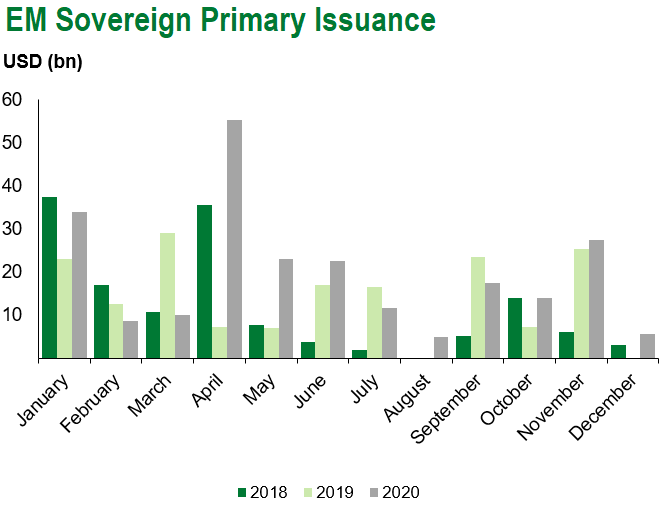
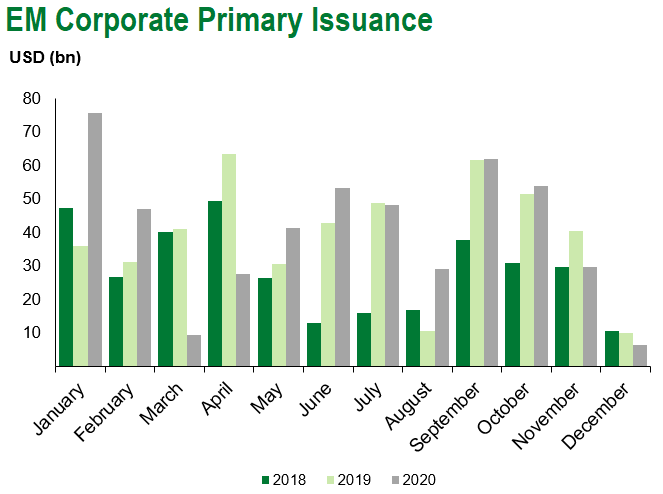
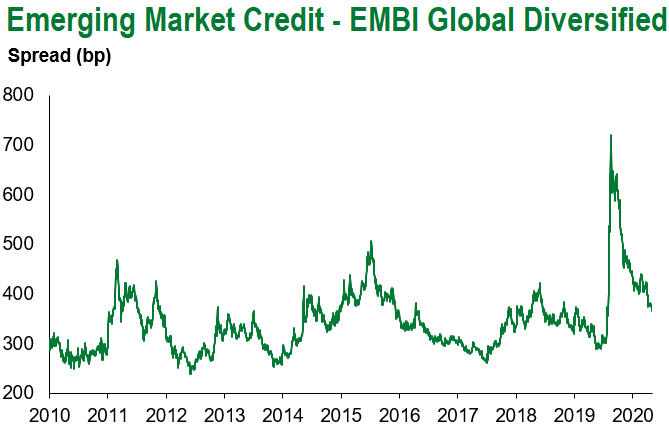
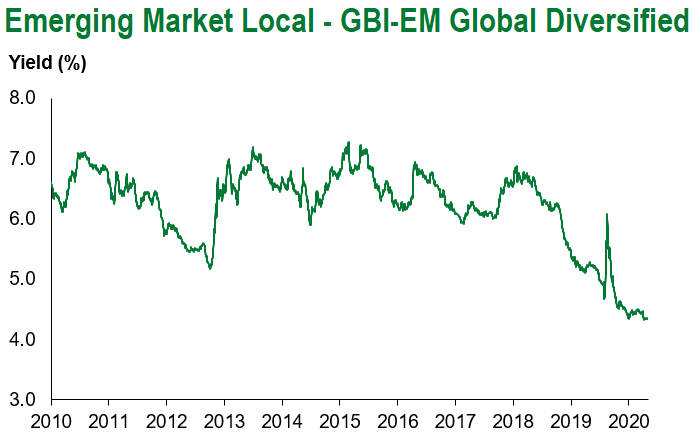
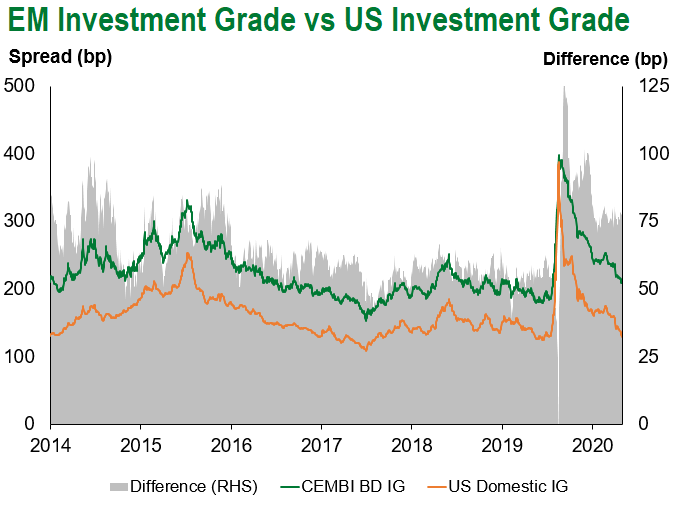
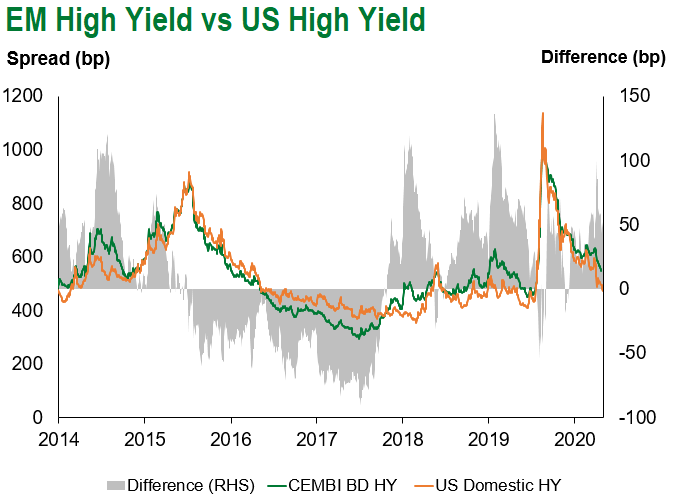
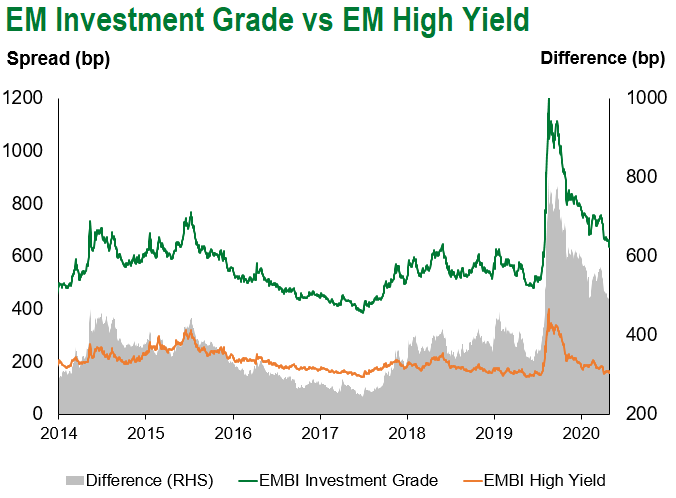
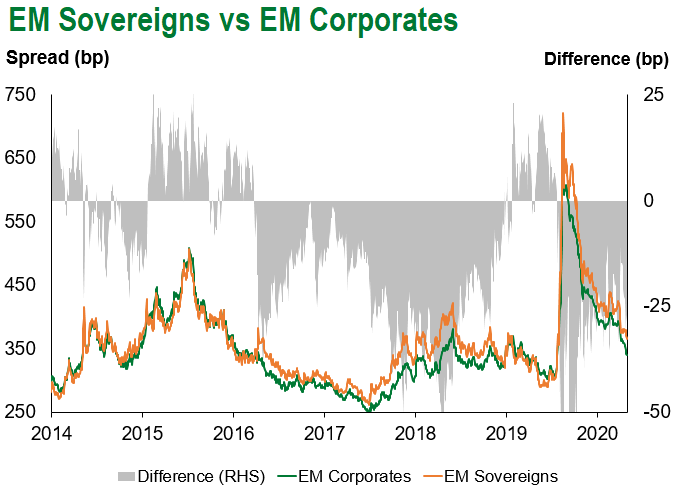
Emerging Markets Flows
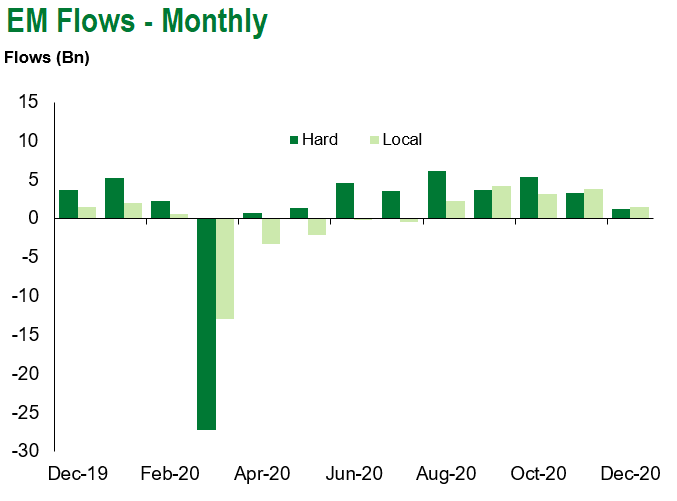
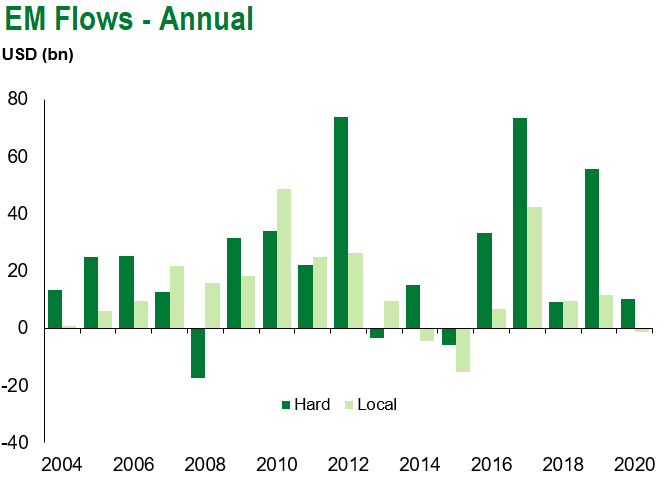
Source for graphs: Bloomberg, JPMorgan, Gramercy. As of December 4, 2020.
COVID Resources
Emerging Markets COVID-19 Case Summary
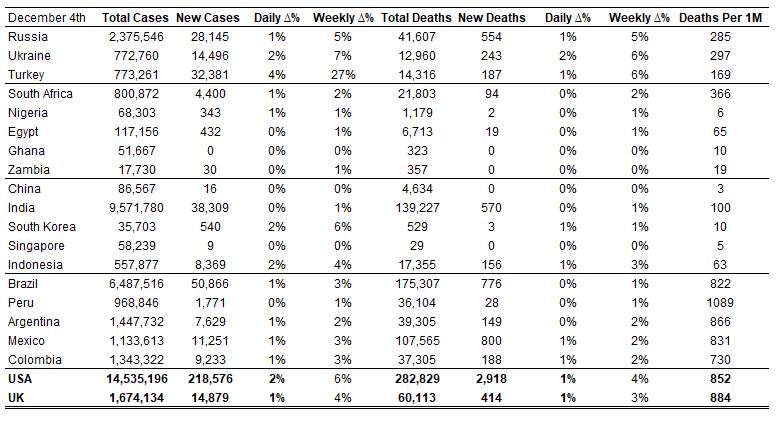
Source: Worldometer as of December 4, 2020.
Additional Crisis Resources:
Johns Hopkins COVID-19 Case Tracker
For questions, please contact:
Kathryn Exum, Senior Vice President, Sovereign Research Analyst, [email protected]
Petar Atanasov, Senior Vice President, Sovereign Research Analyst, [email protected]
Tolu Alamutu,CFA, Senior Vice President, Corporate Research Analyst, [email protected]
James Barry, Vice President, Corporate Research Analyst, [email protected]
This document is for informational purposes only. The information presented is not intended to be relied upon as a forecast, research or investment advice, and is not a recommendation, offer or solicitation to buy or sell any securities or to adopt any investment strategy. Gramercy may have current investment positions in the securities or sovereigns mentioned above. The information and opinions contained in this paper are as of the date of initial publication, derived from proprietary and nonproprietary sources deemed by Gramercy to be reliable, are not necessarily all-inclusive and are not guaranteed as to accuracy. This paper may contain “forward-looking” information that is not purely historical in nature. Such information may include, among other things, projections and forecasts. There is no guarantee that any forecasts made will come to pass. Reliance upon information in this paper is at the sole discretion of the reader. You should not rely on this presentation as the basis upon which to make an investment decision. Investment involves risk. There can be no assurance that investment objectives will be achieved. Investors must be prepared to bear the risk of a total loss of their investment. These risks are often heightened for investments in emerging/developing markets or smaller capital markets. International investing involves risks, including risks related to foreign currency, limited liquidity, less government regulation, and the possibility of substantial volatility due to adverse political, economic or other developments. The information provided herein is neither tax nor legal advice. Investors should speak to their tax professional for specific information regarding their tax situation.